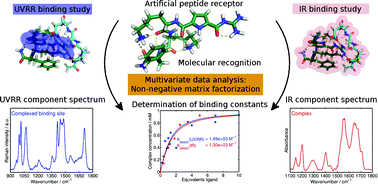Vibrational spectroscopic investigations on molecular recognition processes are surprisingly rare, even at the qualitative level. In this first comparative study, we employ Fourier-transform infrared (FT-IR) and UV resonance Raman (UVRR) spectroscopy for quantitative label-free monitoring of molecular recognition processes. Specifically, the complexation of two different tetrapeptide ligands by an artificial receptor is investigated. The central advantage of UVRR is its capability to selectively probe the binding site of the receptor in the free/unbound and complexed form. In contrast, FT-IR probes the entire receptor–ligand complex without spectral selectivity, thereby providing complementary vibrational information. Multivariate analysis of the experimental IR/UVRR binding studies is required for determining association constants and the vibrational spectrum of the complex, which is not directly accessible. Both FT-IR and UVRR spectroscopy provide similar association constants for the two different tetrapeptide ligands. Complementary DFT calculations support the interpretation of the observed spectral changes upon complexation, which is a prerequisite for extracting structural information from vibrational binding studies.

You have access to this article
 Please wait while we load your content...
Something went wrong. Try again?
Please wait while we load your content...
Something went wrong. Try again?


 Please wait while we load your content...
Please wait while we load your content...